India’s biggest slum faces wrecking ball as residents fear change
Residents of Mumbai’s Dharavi shantytown are anxious about their future as the slum faces $2.4bn redevelopment.
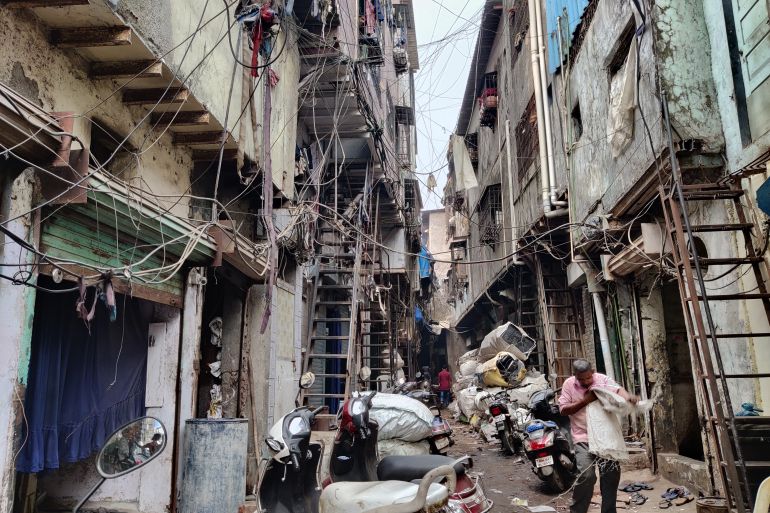
Mumbai, India – Dharavi, the infamous slum depicted in the 2008 Oscar-winning film Slumdog Millionaire, is set for an expensive makeover.
In November last year, Adani Realty, led by billionaire Gautam Adani, Asia’s richest man with an estimated worth of more than $130bn, won a bid to redevelop the Mumbai shantytown, whose blue tarpaulin-lined huts and shanties are the first glimpse of India that many international visitors get when arriving by plane.
Keep reading
list of 4 itemsIndian billionaire Adani is now NDTV’s biggest shareholder
India: Why is Gautam Adani so interested in NDTV?
Billionaire Adani to own 65% of India’s NDTV as founders sell
On the surface, the project appears to be a win-win situation. While families that currently live in dilapidated tenements will get to move into homes in modern buildings, Adani Realty will get to develop a real estate gold mine in the heart of Mumbai.
Once the existing residents are resettled, Adani Realty, which bid a little more than $612m to clinch the redevelopment project, will be able to develop the freed-up land as residential and commercial real estate and sell it at market rates. The entire project is estimated to be worth up to $2.4bn.
Many Mumbai residents hope that a new influx of real estate will help stabilise the housing market in a city where home ownership and even rental accommodations are becoming prohibitively expensive. But not everyone in Dharavi is happy about the plans.
“I worry about the impact on our livelihood,” Sharifa Wagadiya, a 51-year-old potter in Kumbhar Wada, an area of Dharavi known for its earthenware businesses, told Al Jazeera.
Wagadiya, whose family migrated from the western state of Gujarat more than 70 years ago, fears that the new homes will not be sufficient for her family’s needs.
“Our family owns three homes, a small warehouse where we store finished products, and this workshop,” Wagadiya said, while dying diyas, traditional earthen lamps used by Hindus during prayers.
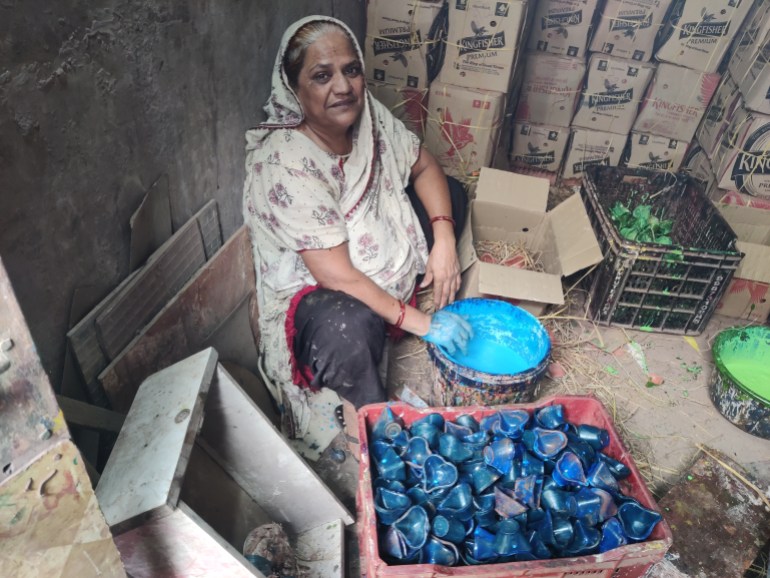
Wagadiya’s concerns stem from the survey carried out to determine the eligibility of families for new homes. When the survey was conducted 14 years ago, all her sons lived with her. But even though two of her sons have gotten married and moved out since then, they are considered part of one eligible family.
“We will get only one 300-350sq ft [27 to 32sq metres] home. We should be given a home for each of my three sons. We should also get adequate space on the ground level to dry and store our earthenware,” Wagadiya said.
The economics of the family business are not very encouraging.
“We spend about 5,000 rupees ($60) on raw materials each month, and our total monthly income from the sale of pottery to wholesale buyers is about 40,000 rupees ($485). But that barely helps us make ends meet, let alone have any kind of savings,” Imran Hussain, Wagadiya’s youngest son, told Al Jazeera while examining a new batch of matkis, small earthen pots, that have just come out of the kiln.
Hussain, 25, joined the family business after completing 10 years of schooling. He is yet to get married and still lives with his parents and grandmother in the family home.
While business can be tough, his face lights up when he speaks of Diwali, the Hindu festival of lights.
“During the two months in the run-up to Diwali, we end up selling all our diyas, and make as much as 200,000 rupees ($2,428)!”
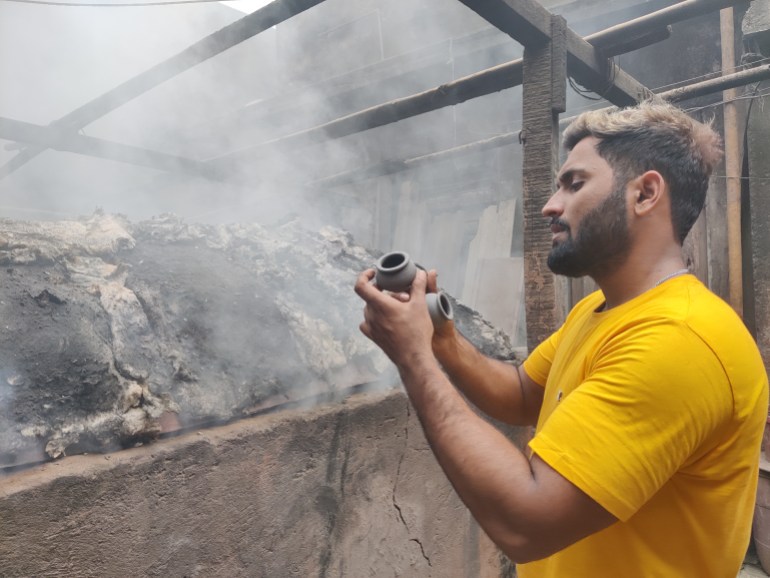
Afzal Khan, a 37-year-old Mumbai native, is also worried about his livelihood. He owns five warehouses in Dharavi that he rents out for about $2,100 per month.
“They are talking about resettling families and manufacturing units. But what will become of my warehouses? I stand to lose my only source of income,” Khan told Al Jazeera.
Jayesh Jain, who runs a plastic recycling business in Dharavi that processes about two tonnes of refuse each day, said the authorities have failed to consult with local residents and businesses about the redevelopment plans.
“No one from the government has spoken to us,” Jain, 40, told Al Jazeera. “No one has asked what we want, what we need… I am paying wages to 30 people including 15 women workers. So, if my business suffers, I’m not the only one affected by it.”
Dharavi covers approximately 2.6sq kilometres (one square mile) in central Mumbai, nestled between the international airport and the wealthy district of Bandra Kurla Complex (BKC), which is home to foreign consulates, five-star hotels, and the headquarters of multinational corporations and banks.
Home to an estimated one million people, Dharavi has the highest population density of any neighbourhood in India. The slum is also a thriving nerve centre of business activity. Dharavi is home to more than 12,000 micro, small and medium enterprises (MSME) engaged in business such as garment making, pottery and recycling.
When the British cleared factories out of the southern part of Mumbai in the early 20th century, workers and low-income families moved to Dharavi and lived alongside the local fishers. Over the years, migrant labourers from states like Tamil Nadu, Andhra Pradesh, Uttar Pradesh and Bihar made the area their home. Today Dharavi has a diverse population of people who speak over a dozen languages and observe different faiths.
Dharavi’s residents live cheek-by-jowl, often in makeshift, two or three-storied buildings put together using corrugated metal sheets, wooden planks, and other scrap materials. The buildings were all built without permits and residents have been struggling to get legal recognition for decades.
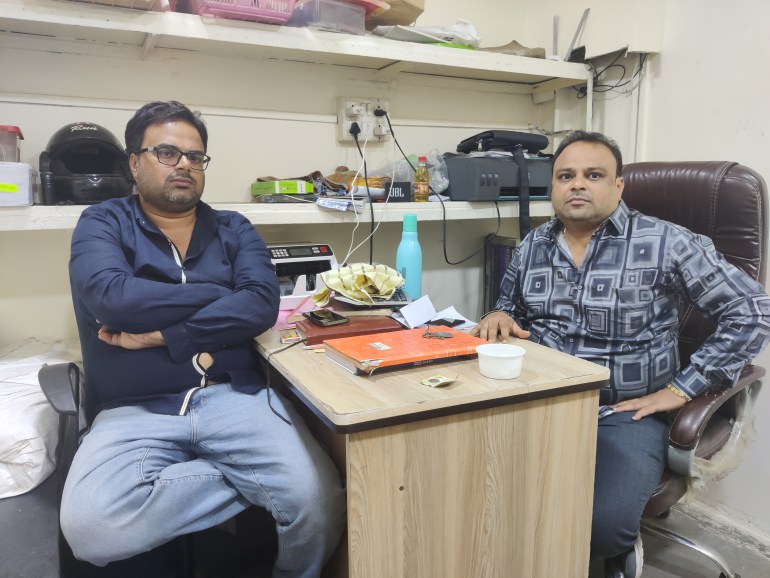
For many decades after India gained independence from the British in 1947, successive governments routinely demolished slum settlements, leaving residents homeless. But with many residents having nowhere else to go, shanty towns soon popped up again. Over time, residents joined hands with union leaders and housing rights activists to demand a more compassionate and sustainable solution.
“People have been stigmatised as ‘slum dwellers’ for generations, including communities which have lived in Dharavi for over 100 years. If people had been seen as legitimate citizens of Mumbai, they would have been allowed to invest in their own civic infrastructure,” Matias Echanove, a partner at urbz, a research collective that specialises in participatory planning and design, told Al Jazeera.
Urbz, which was founded in 2008, has an office in Dharavi itself and has been working closely with its residents to address their concerns.
“Dharavi has not been allowed to complete its transformation from slum to neighbourhood,” said Samidha Patil, another partner at urbz. “We see it as a homegrown neighbourhood, which has an immense potential for improvement. The potential lies within the neighbourhood. Residents of Dharavi need to be supported in their initiatives rather than dismissed.”
Echanove said the residents of Dharavi have been investing in their homes and businesses for years and should be allowed to keep doing so.
“Incremental development and planning could and should go hand in hand,” Echanove said.
“Moving everyone into apartment blocks would restrict this development and lead to the destruction of livelihoods and displacements.”
Ramesh Prabhu, a housing rights activist in Mumbai, said the redevelopment of Dharavi is long overdue after years of “bureaucratic delays and vote-bank politics”.
“This should have happened at least 20 years ago,” Prabhu told Al Jazeera.
“Many NGOs had conducted surveys of residents. The government should have used that data and started keeping its own legal records of residents. This way we could have avoided delays in determining who is eligible for free homes under the rehabilitation scheme, and the whole process of redevelopment could have started decades ago.”
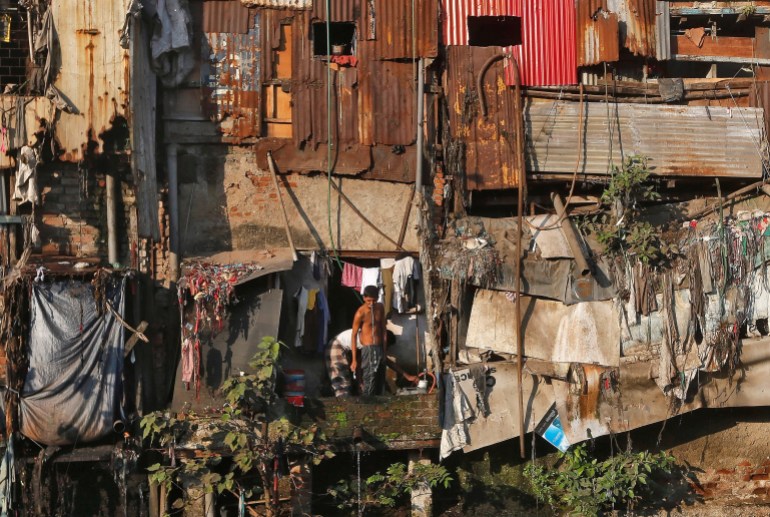
Dharavi’s future only began to receive serious consideration following the establishment of the Slum Rehabilitation Authority (SRA) in 1995.
In 2003, the Maharashtra state government decided to redevelop Dharavi as an integrated township. However, the plans drew protests from residents wary of the size and quality of homes being offered in the redevelopment.
Multiple invitations to tender were made over the years but the project failed to take off. Eight companies from India, the Middle East and South Korea participated in a pre-bid meeting before the latest tender floated on October 1, 2022, according to MoneyControl. After numerous false starts over the decades, Adani Realty secured the project with its bid in November 2022.
SVR Srinivas, CEO of the Dharavi Redevelopment Board that is overseeing the project on behalf of the state government, which holds a 20 percent stake in the project, said the redevelopment will offer a variety of housing options to suit residents’ needs.
“We are going to first focus on providing homes to project-affected families,” Srinivas, who is the chief secretary of the Mumbai Metropolitan Regional Development Authority, told Al Jazeera.
“While free homes will be provided to eligible families, we are also going to offer homes for rent at cost to those who do not meet the cut-off criteria, and give them the option to buy the property on a hire-purchase basis.”
Some of the homes will be built on a 19-hectare (47.5-acre) plot of land outside Dharavi that was acquired from the railways.
“This plot of land is physically adjacent to Dharavi, so people will be relocated in close proximity to their original homes and places of work,” Srinivas said.
This proximity is essential, according to housing activists.
“In case of many other previous slum rehabilitation projects, people would be resettled in far-flung places and this impacted their livelihood. So, they would just rent out or sell those homes and come back to the same spot and the slum would spring up again,” Prabhu said.
Eligible families are those who can prove that they have been residents since before the cut-off date of January 1, 2000. There were approximately 58,000 such families when the government last conducted a survey of residents in 2009.
But the actual number of families, including those who are ineligible, is estimated today to be closer to 100,000. Many are families like Sharifa’s that have grownup children who moved out of the family home in the time since the survey was conducted.

A spokesman for Adani Realty said he could not comment on the project until the company had received a letter of intent from the government.
Back in the Dharavi neighbourhood of Kumbhar Wada, Dhansukh Kamailya, a potter from Gujarat state, is wary of the “narrative of ‘free housing’.”
“The new homes are in exchange for our existing homes that will be demolished,” Kamailya told Al Jazeera.
Kamaliya, whose family business has been in operation for more than 90 years, said potters are a proud lot.
“Our self-respect comes from our self-reliance. Our craft is a source of our livelihood, without it, we cannot be atmanirbhar (self-reliant),” he said, using a term used by Indian Prime Minister Narendra Modi as part of his “Self-reliant India” campaign.
For residents such as Wagadiya, toilet facilities are another concern.
“When I came here after marriage, my mother-in-law’s mother-in-law was still alive, and I saw how much she struggled in her old age. So, I insisted on building a toilet and bathroom in our home,” she said. “Will Adani give me my own toilet?”
The city government has assured residents that all new homes will include toilets.
“After all formalities are completed, we will be releasing a master plan for the project,” Srinivas said. “We want the public to see that we are committed to addressing all concerns about the rehabilitation of project-affected people, especially those pertaining to the small businesses and manufacturing units.”
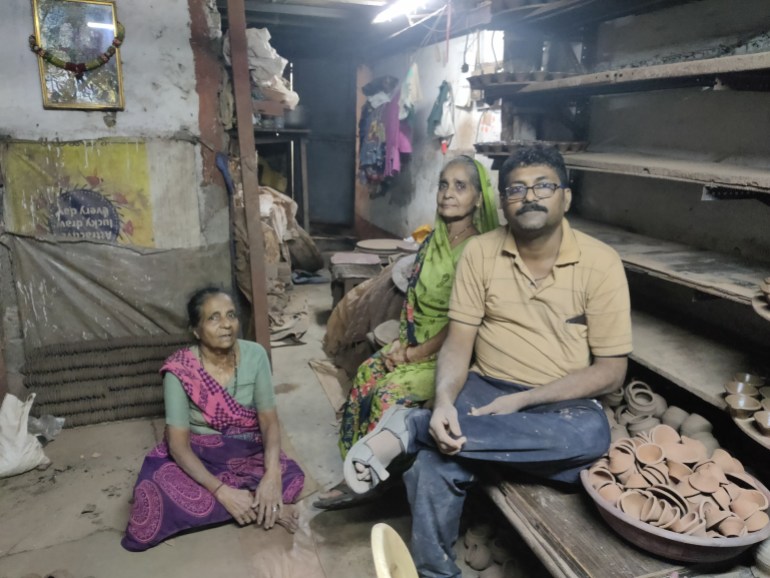
Unlike Wagadiya, most of Dharavi’s residents rely on public toilets that are scattered across the slums, as their homes do not have indoor toilets and bathrooms.
Until about a decade ago, some residents would still relieve themselves along railway tracks early in the morning. Some still feel deeply ashamed about how their struggles were depicted in Danny Boyle’s Slumdog Millionaire, which features a scene in which the child protagonist plunges into a pit of faecal matter.
Even today, a number of travel and tourism companies are trying to erase that image of Dharavi by offering tours to foreign visitors that showcase how the slum has a thriving economy and is home to hard-working, entrepreneurial people.
“When I first visited Dharavi in October 2005, people who lived outside Dharavi feared it. Many friends warned me that if I enter Dharavi, I won’t be able to come out,” Krishna Pujari, who runs Reality Tours and Travel, told Al Jazeera.
“I saw hard-working people who were proud of the fact that they had built a life for themselves with their own talent and perseverance,” he added. “I wanted to showcase that in my tours.”
Today, Pujari is often stopped by people in Dharavi wanting to greet him or ask him for help.
“We have been running youth empowerment and digital literacy programs in Dharavi,” he said. “We also used to run a school, but that had to be shut down during the COVID-19 pandemic. We are now focusing on expanding our projects to rural India.”
While Pujari stands to lose income from Dharavi’s redevelopment, he is not worried.
“I have tours running all across India. The loss of income from Dharavi tours will not impact me much, but the people here stand to lose their livelihood if their concerns surrounding the relocation of their businesses are not addressed,” he said.
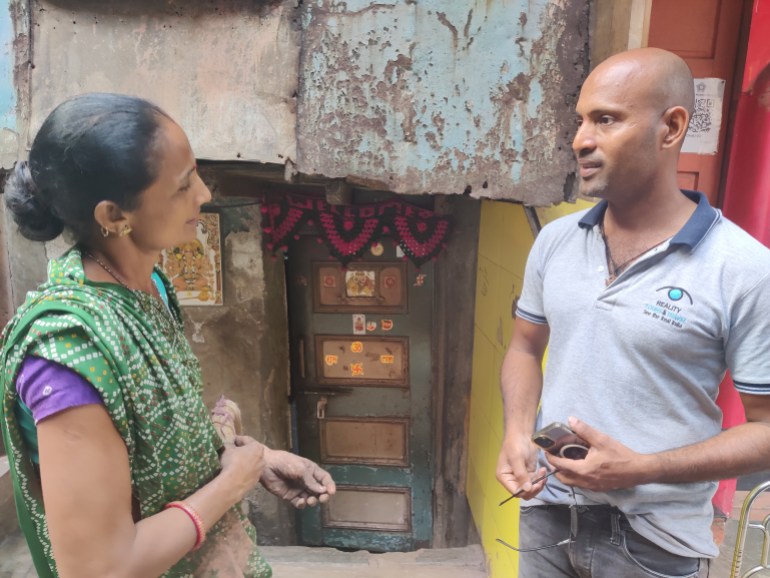
Srinivas said the government is sensitive to the needs of small business owners and is considering a 5-year exemption from the goods and services tax among other incentives to encourage industry.
“Plus, we would like to bring them under a more organised system where they can benefit from better measures to not only grow their businesses but also control pollution,” he said.
Srinivas said he expects the project’s “master plan” to be released within six months of all formalities being completed.
Until more details are made public, anxiety about the future of Dharavi is all but certain to persist among its residents.
“Dharavi is centrally located and close to five railway stations, making it highly accessible, said Kamaliya, the potter in Dharavi’s Kumbhar Wada neighbourhood. “It is a sone ki chidiya (golden bird) that everyone wants.”